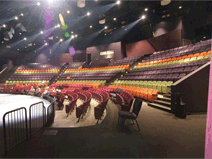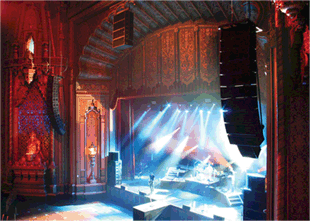Mastering Every Venue For Theater Sound Success
There are as many different types of “theaters” as there are songs to sing, so what are theater clients looking for in sound system design? Is it magic, know-how, technology, or an amalgam of the three that separates a good system from a great one?
The Fox Theater in Oakland, CA, was reopened after being shuttered for 43 years, and temporarily used a full L-Acoustics V-DOSC system.
Karl Winkler, director of business development with Lectrosonics, said that advancements in microphone transmitters and a growing awareness of sound quality are driving the evolution of theater sound. Designers are currently pushing the envelope, he observed, and they need technology that’s robust yet versatile enough to support it: “They want the best, the most fantastic concepts. Mics that used to work fine simply aren’t good enough anymore.”
Any bottom line with design, and theater sound particularly, is that designers are looking for a blank slate. “You don’t want to see the lights,” he said, “just the effects of the lights. [Designers and installers] work hard to make sure the audience doesn’t get hung up on technological details. You want it to be a transporting experience taking you out of the theater, out of the parking lot, somewhere else.”
Critical to that transformative experience is invisibility—the less sound equipment you can see the better. The medium itself must be transparent so suspension of disbelief is preserved. This concept has been discovered by the theater industry, and the quality is spectacular. From the American Conservatory Theater, to Cirque du soleil’s O, to Shakespeare in the Park, microphone technology allows for experimentation inside the theater sound system: “Making things happen that simply couldn’t happen before,” Winkler said. Wireless mics are an ideal solution for modern staging because there are no trailing wires, no boundary mics. They offer better control and accurate localization to avoid cognitive dissonance. Distant mics pick up ambient sound, a problem eliminated by close mic’ing.
What’s more, the wardrobe crew and performers enjoy the new generation of mics because they are lighter and smaller. (Lavalier mics are now the size of a match head. Body mics continue to shrink.)
Clearly, consultants and integrators have a wide variety of products from which to choose, but are there funds to start the projects? Perhaps it’s better to design and implement an expandable system now that meets budget requirements but can be upgraded when funds return?
Dohn Fadden, a design consultant with Electronic Design Company (EDC), says that if the money isn’t there now, invest in a solid infrastructure. “Keep the future a priority,” he said, “more and more equipment is a commodity item. The way technology is going, everything will be DSP. Infrastructure is the key.”

A 700-seat multi-use theater in Miami’s Calvary Christian Academy includes Lectrosonics Venue receivers and LM belt pack transmitters.
What does he mean, exactly? Once a steal at $50,000, digital consoles can now be purchased for well under $10,000. It makes sense to install a system that covers the bases now, but can be upgraded when the need arises. If budget is a serious concern in theater sound design, it’s also helpful, Faddon suggests, to ask if or where rental systems can fit in.
Faddon and the EDC team have first-hand experience navigating budget and innovative design in a recent project in Burnsville, a suburb of Minneapolis/St. Paul, MN. “Many folks know Burnsville for the mall, but that isn’t even the real downtown,” Faddon reflected. “The mayor set out to revitalize downtown.” An essential piece to the rejuvenation to Burnsville’s urban core was the restoration of the Burnsville Performing Arts Center, of which Faddon was the design consultant (see related sidebar).
He wanted to start off with great technology, but like most cities in the U.S., budgets are tight; he didn’t have carte blanche. “We needed to do something that could work all around, but that was expandable.” A major component of the BPAC Faddon selected is the networked audio system from Electro-Voice.
The team had to get creative with the multi-purpose design (BPAC hosts myriad events such as concerts, comedy, musicals, plays, and open-air events like weddings). They also had to do “some fancy structural work,” he joked, with a finicky wall. “One challenge was the left/right speaker hangs. There is a wall with a design in it, almost a secondary wall, and it wasn’t in the original design.” They had to some veritable technology magic tricks to make sure the fly was okay. (Which it was.)
Faddon’s vendor and a neighboring Minneapolis manufacturer, Electro- Voice, helped the project stay on budget with the right equipment. They really “stepped up to the plate,” he recalled.
Like Burnsville, a city in California is experiencing a downtown renaissance of sorts. The Fox Theater in Oakland, CA, has reopened after being shuttered for 43 years. A substantial restoration project to the 2,800- capacity venue has updated the theater with the latest acoustic technology while preserving its original flair. The multiple seating configurations include general admission, cabaret style seating, and reserved seating. The Fox Theater says it is the centerpiece of the revitalized Uptown District section of Oakland that will feature fine dining and 2,000 new residential development units.
Bay Area promoter Another Planet Entertainment now uses the Fox Theater as its live music venue, and tapped Sound On Stage to temporarily fly a full L-Acoustics V-DOSC system.
California-based Sound On Stage unites touring and local sound engineers to work with San Francisco and national corporate producers, party planners, and music promoters.
Though not a permanent install, it delivered a unique theater sound experience while it was installed. Musicians who benefitted from the LAcoustics rig include B.B. King, Bloc Party, Green Day, and Franz Ferdinand, among other top acts.











